December 4, 2007 at 11:53 am · Filed under Roadtrips
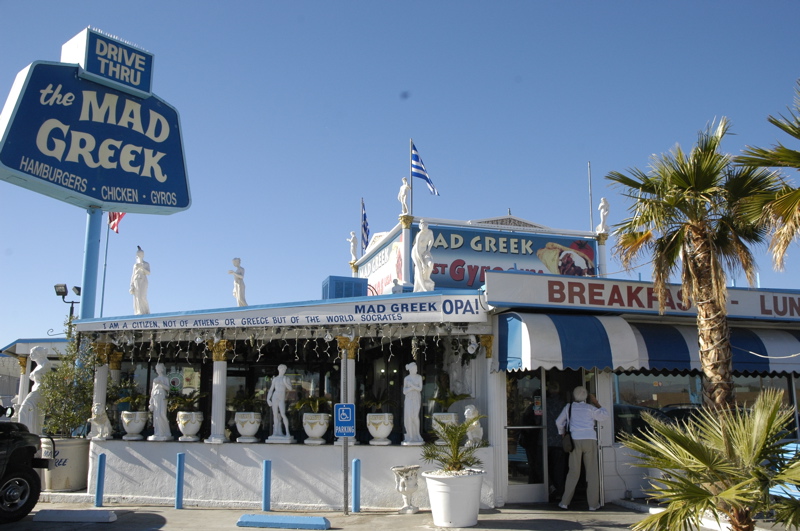
He’s big, he’s bad, he’s … oh wait, he’s a myth. It says so inside the restaurant. There’s no such thing as a mad Greek, according to signs, which also bust other “Greek myths” and list dozens of influential Greeks. There’s some serious Greek pride here, and I don’t mean the fraternity type.
Right along I-15 in the desert town of Baker CA, you’ll find The Mad Greek, home of the “best gyros”. This place combines the indoor atmosphere of the Madonna Inn with the food of a Tarpon Springs (FL) restaurant. Kind of fun, and they make a “fresh strawberry” milkshake that is justifiably boasted about on billboards up and down I-15. We made it our lunch stop on the way to the Las Vegas area.
After a beautiful drive through the wide open country, we are now parked in the driveway of our friends Brian and Leigh, who were famous in the Airstream community for their full-time blog called 63flyingcloud.com. (The blog has since been continued by the new owners of that Airstream.) Being former Airstream travelers, our hosts know exactly what we like, and so we have water, electricity, wi-fi, access to the house, and an offer of dinner tomorrow night. We’ll spend two nights and figure out what we should be doing next.
December 3, 2007 at 9:11 pm · Filed under Roadtrips
This time of year, even in the southwest, our major challenge is nighttime cold and early sunset. The short days mean that we need to plan carefully to get our driving done by 5 p.m., and at night the temperature in the desert plummets abruptly and requires us to use the furnace.
Still, I like to boondock in the desert when we get the chance, and today is one of those chances. To be ready, we need all the systems topped off. Out in some of the lonelier spots in the desert, even in some camping areas, you can’t count on any support or services.
So today we filled the fresh water tank and dumped the holding tanks before leaving the campground, our usual procedure. We always travel with full fresh water because — even if we are planning to go to a place with hookups — plans change. This policy has saved our day many times. Then we stopped off for a big grocery shopping expedition near Santa Clarita, and filled both propane tanks. At California prices, 14.5 gallons of propane (we were nearly empty) cost $54.50, the biggest single propane bill we’ve ever had.
Living in the Airstream certainly makes us well aware of what we consume on a daily basis. We took on 30 gallons of fresh water, 14.5 gallons of propane, 20 gallons of gasoline, and nine bags of groceries. We also dropped off one grocery bag of trash, about 20 gallons of gray water (four “Hollywood” showers and some dishes), and about 5 gallons of black water. I’d topped off all the tire pressures in Riverside a week ago, so we didn’t require any compressed air, and our batteries were already full courtesy of the sun.
The goal for tonight was simply to end up somewhere between Ventura and Las Vegas for a night, but what I really wanted was a quiet spot in the desert where we could see the stars. We skirted the north side of the Los Angeles metroplex from Santa Paula to Santa Clarita, then to Victorville and northeast on I-15. This avoided the worse of traffic, but still we found ourselves in a minor traffic jam near Santa Clarita.
Normally I don’t drive in the HOV (High Occupancy Vehicle) lane because we generally try to avoid places where HOV lanes are necessary. Also, in California all towing vehicles are limited to 55 MPH, which is a speed no self-respecting California will drive in a car if they don’t have to. So driving in the HOV lane with a trailer is a quick way to make enemies on the road.
But this time I made an exception because the HOV lane was the only one moving and legally we qualify with three people in the vehicle. While breezing down the road I reflected that we drive an SUV, and with the trailer we are an SUV-RV combination, and now we were an HOV-SUV-RV. But only for a few minutes.
[Edit: Don’t do this. Apparently towing in the left lane is illegal in California, which I discovered only later from a blog reader’s comment.]
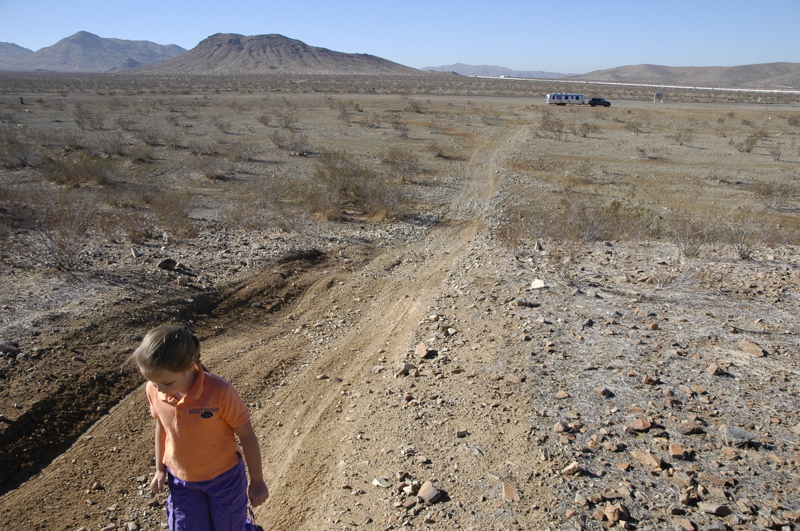
Next morning at Stoddard Valley OHV Area
Along I-15 south of Barstow is the Stoddard Valley Off-Highway-Vehicle (OHV) Area, and after dark it seemed an ideal spot to stop for the night. Two exits lead to large dirt parking lots and a maze of roads through desert sage and cactus. We’re parked in one of the dirt lots, which I think makes us into an OHV too.
There are absolutely no services here, no lights, no rangers, nothing. Just a quiet spot within view of I-15 but far enough back that we can’t hear the highway inside the trailer. According to the web site campers can stay up to 14 days. There’s nobody here other than us tonight, probably because it is Monday and the temperature dropped into the 40s after sunset. That’s fine with us. It should be a pleasant night here, in our OHV-SUV-RV.
December 2, 2007 at 8:48 pm · Filed under FAQs
In years past we’ve come back from a vacation and had to face grim aspects of “real life”, which usually included freezing weather, a pile of backed-up mail and phone calls, and a house that needed some attention right away. In this case, coming back from Hawaii has been a relative pleasure because we landed in Los Angeles where the sun was shining and the temperatures were in the 60s. It was less of a shock to the system, coming from humid days in the 80s.
But the best part was coming back to the Airstream. At last, a bed I can sleep in. Our own kitchen again. No more unpacking and re-packing. No more people at airports telling me that my bottled water is too risky to carry on board an aircraft. My own DVD collection rather than pay-per-view on the hotel TV. It’s great to be back home and yet still able to travel.
To be fair, there were a few things to deal with. We had removed a lot of stuff from the truck and put it in the Airstream for safekeeping, including three bicycles, some tools, the sewing machine, etc. With Los Angeles traffic we got back to our storage spot after dark, and we couldn’t stay in the storage lot overnight, so we had to re-arrange everything, hitch up, and tow about 1/4 mile to a campsite. But in 20 minutes or so we were set up for the night, which is about the amount of time it took us to get checked into our Waikiki Beach hotel, get a parking pass, and unpack in our room. We’ll keep the Airstream hitched up overnight and pull out tomorrow to points as yet undetermined.
One small lifestyle change is the need to re-adapt from the hotel shower to the RV shower. In the hotel, we had a cascade of water, and hot stinging needles if we wanted them, flooding the tub so quickly that the drain couldn’t keep up. This was the sort of shower that people seem to like, not so much because they get cleaner but because it feels like a “spa” experience. You don’t get pummeled by hot water much in an RV, and that seems to really bother some folks.
This is probably why I get so many reports from people saying that their “gray water” tank doesn’t last long enough when they are not connected to a sewer hookup. (The gray tank is the tank that holds used water from the shower and sinks.) It’s true, the tank is never as big as you’d like it to be, but with a little careful conservation you can last a long time. The problem I usually find with people who are filling the tank quickly is that they’ve never learned to conserve water.
There are two things that really fill up the gray tank fast: Showers, and dishes. A lot of people switch to paper plates when they are trying to make the gray tank last a long time. We’ve done that, but we’ll also use campground dish-washing facilities if they exist, as we did at Yellowstone.
You can do the same with showers if you are in a campground where they are available. Some people use the campground shower religiously, because they don’t fit in the small travel trailer shower, or because they just prefer the “home style” shower when it is available. Personally, I like my Airstream shower and I hate using the campground showers, so I’ll go to some effort to be able to shower in the trailer.
This means the “navy shower” is essential. It’s a simple technique: turn on the water, get wet, turn off the water. Then soap up everything, and rinse off quickly. Get really good at it, and you’ll find you can take a complete shower in about three gallons, or about 90 seconds of running the water. That makes you an Admiral in the Navy Shower Fleet.
Even an Able Seaman should be able to do it in less than six gallons (just over two minutes). Get it down to a flat two minutes (five gallons) and you’re a Lieutenant, or four gallons (a minute and a half) for the Commander’s rank. This assumes you have a typical RV showerhead that lets 2.5 gallons per minute through.
If you blow it, the Airstream has a built-in warning sign. The hot water tank is usually six gallons. If you start feeling cold water, you’ve used all six gallons plus a bit more (because the tank is constantly re-heating) and you’ll soon be walking the plank when the rest of the family finds out. Even in a full hookup campground where you don’t have to worry about running out of water or filling the gray tank, the six-gallon limit still applies.
The other thing you need to know is the size of your gray water holding tank. Ours is a fairly roomy 39 gallons, which means all three of us Admirals can take showers in a total of less than 10 gallons, giving us three showers each plus some tooth brushing and dishes, before we run out of holding capacity.
It’s really not hard to learn the navy shower technique. Camping without a full hookup does require some small sacrifices, but you can still have a satisfying shower. The inability to stand under a spray of hot water for ten minutes is nothing when you realize that small sacrifice enabled you to walk out your door into the landscape of a great national park, or a quiet beautiful place far from crowds.
December 1, 2007 at 11:15 pm · Filed under Uncategorized
It has been a relaxed, un-rushed week in Oahu, but with today being our last day we felt the pressure of the things left undone. One of the top items on our list was to have dim sum in Chinatown, since we may not be able to get to San Diego to have it with our friends Bill and Larry. I was also surprised to discover that Eleanor had only had dim sum once in her life, at the age of 19, which was (mathematically speaking) centuries ago. Finding a culinary experience that Eleanor has not had is a rare thing. The things you discover after 14 years of marriage …





Emma had a battle with the chopsticks. She has used them before, but dim sum put her to the test. To her credit, she was not defeated and resisted the offer of a fork.
Dim sum was a huge success with all. We had a delicious brunch at Mei Sum in Chinatown and I can highly recommend the place. For all three of us the total was only $20 and we walked out quite stuffed.
Another thing on our list was to drive the Pali Highway over the mountains and get a view from the highway overlook. The mountains were shrouded in clouds and the overlook was closed, but the drive was beautiful anyway. We ended up exploring a few state beaches on the windward side, until Eleanor spotted the Honolulu Nut and Ukulele Company in Waimanolo. (Strange combination, I know.)
There’s a backstory here. Years ago in Rockport ME I bought a cheap $30 uke and a songbook, and then never really got up to speed with the ukulele. When we sold our house, Eleanor insisted on taking it with us in the Airstream. It has ridden around with us for two years, virtually untouched. About two weeks ago I ran into Tommy Green at the Airstream rally near Los Olivos, and he cajoled me into trying again. Tommy, a fellow Airstreamer, has a collection of ukes and is pretty good with them.
In two weeks we will meet Tommy and Kathy Green in the California desert and I expect to get two or three days of uke lessons. I want to make them count and actually come out strumming. So I went into the Hawaiian Nuts and Ukulele Company and bought a tuner and a beginner’s guide. All was well until I decided to try some of the better quality ukes to see what the difference was between a $30 cheapie and a … um. … somewhat more expensive model.
You can see where this is going, can’t you?
Well, I really liked the tenor ukulele made of mango wood for its big sound and comfortable feel, and of course to take it home I needed a case. Now I have a very nice tenor uke — my Christmas present from Eleanor — and Emma has a $30 soprano uke waiting for her under the bed in our Airstream, in like-new condition. While I was in the store, the staff taught me three chords and I can actually play them fairly well already. With a little more practice I’ll be ready for Tommy’s tutelage, and if I’m lucky Emma may come right along with me.
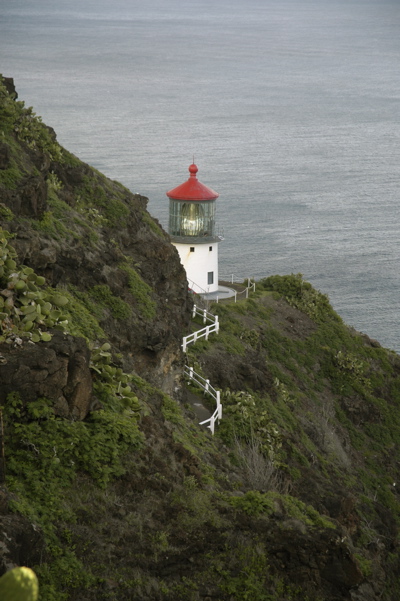 A little further south along the windward coast is Makapuu Point, and a state wayside where you can hike a paved trail about a mile up to a high point with panoramic views. There’s a cute little lighthouse visible from the trail, but the best part is the view toward Makapuu Beach State Park and the bird sanctuary islands of Kaohikaipu and Manana. The reef areas off the beach are clearly visible with polarized sunglasses. If we had another day I would certainly return for some snorkeling.
A little further south along the windward coast is Makapuu Point, and a state wayside where you can hike a paved trail about a mile up to a high point with panoramic views. There’s a cute little lighthouse visible from the trail, but the best part is the view toward Makapuu Beach State Park and the bird sanctuary islands of Kaohikaipu and Manana. The reef areas off the beach are clearly visible with polarized sunglasses. If we had another day I would certainly return for some snorkeling.
All over the island at beaches and waysides there are warnings not to leave valuables in your car. Sadly, break-ins are common. While we were parking at Makapuu State Wayside the police showed up to take a report from some sad tourists whose car was broken into in the middle of the day. The parking lot was busy with people coming and going but apparently the thieves just waited for a quiet minute. That’s all they need to conduct a simple “smash and grab” theft. You really can’t take chances here with valuables in a car.
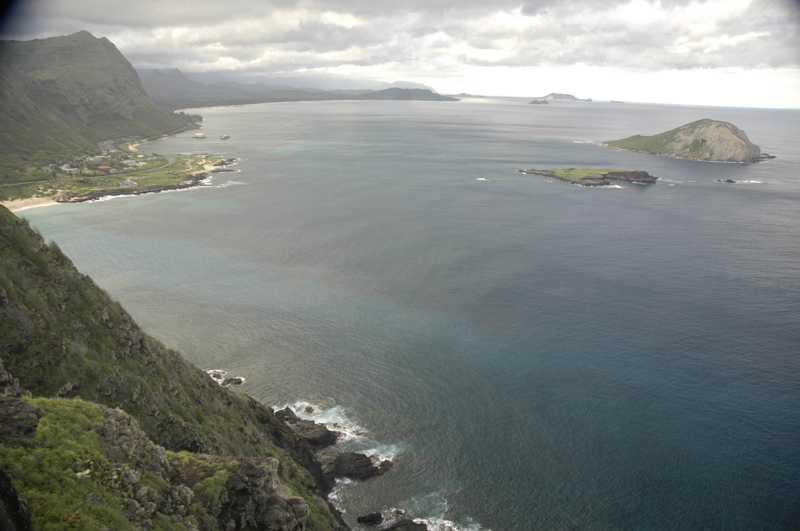
My friend Bill Reilly called while we were on the hike up the point. He’s decided to build an Airstream coffee shop, and is looking for an Argosy 20 shell. The Argosy is essentially a “painted Airstream” that was built in the 1970s. Anyone who knows of a short one available for a reasonable price in the southeast US, let me know.
So with those things and another round of Bento boxes for dinner, we’ve wrapped up our Hawaiian vacation. Sunday we fly back to California and resume the Airstream life. It has been fun here but I’m looking forward to getting home. I have found I sleep better in the Airstream, and I can work more efficiently, and we only have a few precious weeks left before we have to return to home base for a while. We’re going to try to make the most of them.
November 30, 2007 at 11:30 pm · Filed under Uncategorized
When planning our trip to Oahu we wanted to avoid Waikiki Beach as much as possible. So we only booked three nights here, and we were right to do so. It’s not a bad place but it is so crowded and built-up that it feels like a mix of Miami, New Orleans, and Manhattan. It doesn’t feel like the Hawaii we are used to, probably because we usually seek out the quiet spots, and Waikiki is a traffic-bound tourist trap.
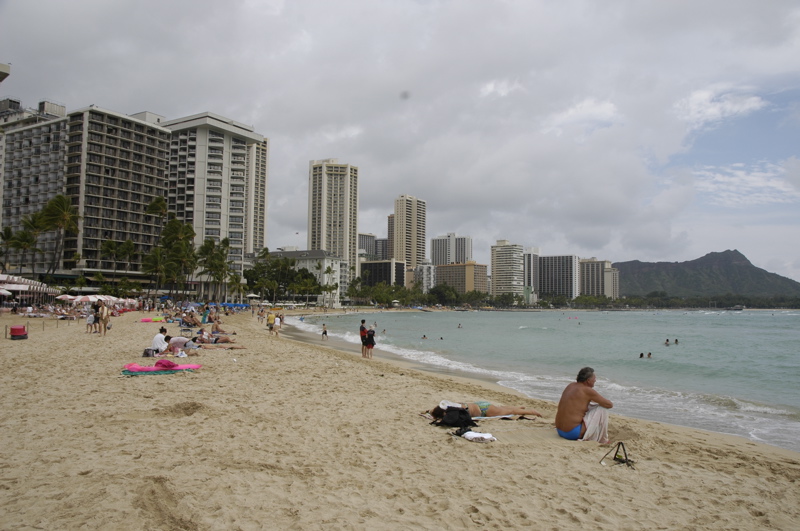
Even the beach isn’t that great. It’s busy, and in some places the towering hotels are right up against the ocean with only a tiny strip of sand for the hordes to occupy. Strange, because just a short drive away by car (or bus ride) are some truly spectacular beaches.
But if you like to shop, Waikiki is great. The main drag is dominated by malls and knick-knack shops. On the Ewa side are all those hoity-toity brands for people who have more money than they know what to do with, and for the average Joe there’s an ABC Store on every block extending for a mile toward Diamond Head. If you can’t find an ATM, a McDonald’s, an ABC Store, or a sushi place in Waikiki Beach, you’re not looking.
There are so many restaurants catering to Japanese tourists here that it feels like we are in Japan at times. Hawaii has had a significant Japanese population since before it was a state, and today it is like an outpost of Japan. Our hotel is Japanese-owned, and all the staff are Japanese. Signs everywhere are bilingual. Our dinners have been udon noodle soups and Bento boxes. It’s fun — we like the food and I like imagining I’m in Japan. Someday we hope to go there for real.
Since the weather today was too cloudy for good snorkeling and occasionally too rainy for sightseeing, we spent the day on foot exploring Waikiki Beach and buying a few Christmas gifts for family. But enough of that. We have had too much of the tourist machine already.
At one point we hopped a free shuttle bus and found ourselves on a one-way trip to Hilo Hattie’s “flagship store” on the other side of downtown Honolulu. Not only could we not escape, but we spent an hour in purgatory on the bus, trapped in dense Friday afternoon traffic (to go six miles). Once we arrived at Hilo Hattie’s there was just enough time for Eleanor to buy the particular brand of Kona coffee she likes, and hop back on the bus again to fight our way back to Waikiki.
There was one bright spot to that adventure. The driver, desperate to avoid the traffic, invented a highly creative route to get us back. This involved driving through a shopping mall parking garage, and at one point, turning down a narrow alley marked “Construction Traffic Only.” As we passed the construction machines in the early evening darkness, an announcement came over the buses P.A. system: “OK … We didn’t go here, and you didn’t see this.” Nope, we didn’t — and we don’t plan to see it again, either.
November 29, 2007 at 11:38 pm · Filed under Uncategorized
We’ve moved from the leeward side of the island over to the classically tourist downtown of Honolulu, known as Waikiki Beach. Here things are much different, with high-rise hotels and lots of prosperity. The tent cities and depressed areas further west seem very distant.
Yesterday afternoon the sun came out again and we went down to Ko Olina, an area of timeshare resorts on the leeward side where four man-made lagoons have been carved out of the wavy seashore. A book I’d read suggested that the lagoons would be good for snorkeling, but they weren’t. That’s what happens when non-snorkelers write tips on snorkeling.
Lagoons tend to collect murk, which kills the visibility. Also, since these were man-made, they have sandy bottoms with no reef or rocks, thus they are unattractive to reef fish. We saw a couple of angelfish and that was about it. But the lagoons are wonderful places to swim, even on a wavy day, because they are well sheltered.
Emma has been clamoring for more snorkeling so we decided to visit Hanauma Bay State Park a few miles east of Waikiki Beach. I was expecting an overcrowded beach and more murky conditions caused by clueless swimmers stirring up the sand and stepping on the delicate reef, but Hanauma was a pleasant surprise.
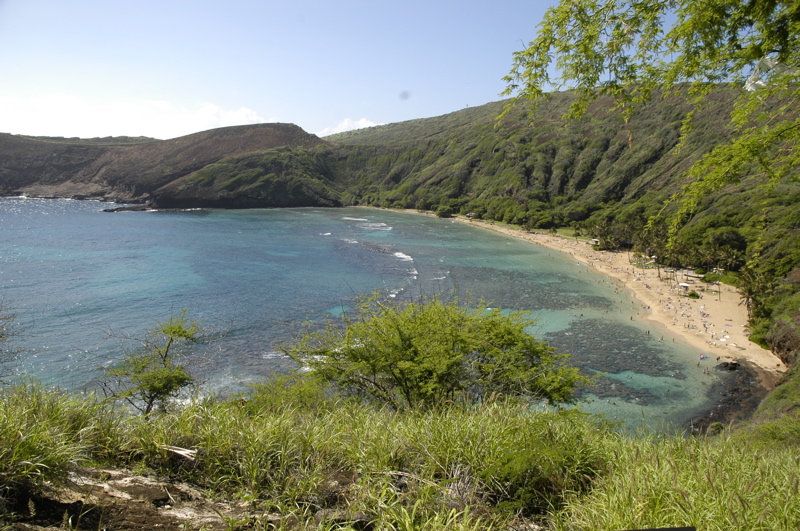
Formed by a flooded ancient crater, Hanauma Bay is reputedly the most beautiful state park in Hawaii, and I can believe it. Popular since the 1950s, it was a bit abused for a while. People overfished it, they trampled the delicate coral (thus killing it), and the first transpacific undersea cable between Hawaii and California was laid right in the middle of the bay. (They did this by blasting a 200-foot wide channel with dynamite, which has since been filled in by sand.)
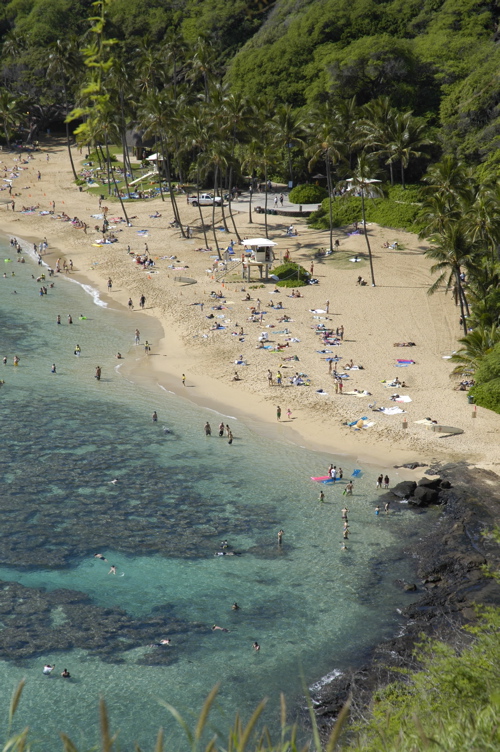 But lately Hanauma Bay been very well cared for by a volunteer group. Now, just to enter the park you must first watch an educational video about how to protect the reef and the sea life. There’s also a very good visitor center with information about the coral, fish, and other sea life. Admission is $5 per person (kids free), and parking is a buck. With all these barriers in place, people seem to really respect the park, and I heard a lot of people talking about the care they were taking to avoid stepping on the living coral, steering clear of the sea turtles, etc. That’s a real contrast to what I have seen around reefs in the Florida Keys.
But lately Hanauma Bay been very well cared for by a volunteer group. Now, just to enter the park you must first watch an educational video about how to protect the reef and the sea life. There’s also a very good visitor center with information about the coral, fish, and other sea life. Admission is $5 per person (kids free), and parking is a buck. With all these barriers in place, people seem to really respect the park, and I heard a lot of people talking about the care they were taking to avoid stepping on the living coral, steering clear of the sea turtles, etc. That’s a real contrast to what I have seen around reefs in the Florida Keys.
Near the shore the water was predictably murky with perhaps 8-10 feet of visibility. Still, Emma was thrilled to spot a moray eel almost immediately (his mouthful of teeth scared her a little), and numerous colorful reef fish. Visibility improved about 100 feet offshore, and with the educational video still fresh in her mind, Emma was extremely careful not to step down or touch the coral.
While she was on the shore resting, I went out past the wave break, maybe 200 yards offshore, and found slightly clearer water and a wider variety of fish. I also spotted a small Green Sea Turtle (called honu by Hawaiians) and watched him eat algae off the coral for a few minutes. Of course Emma couldn’t pass up on this, so I took her out to the deeper water and we spotted another, slightly larger sea turtle. By all accounts, it was a very successful couple of hours of snorkeling.
I read a Dave Barry essay once where he described visiting the ocean and not going underwater as being like going to the circus and just watching the outside of the Big Top. It’s true. Under the sea is the real show, full of incredible creatures and tiny dramas. I watched a school of Convict fish swarming coral areas for food, while a solitary little brown fish bravely attacked them one at a time to drive them away from his territory. I watched a moray eel swim slowly in and out of his little cave, baring his menacing teeth. Little yellow tangs swam timidly below me, while a green sea turtle placidly bounced from one coral outcrop to another. There were strange things buried in the sand and deep in coral caves that we only spotted because they moved. And yet from the shore it was just another beautiful Hawaiian beach.
We get looks from people because we snorkel in our shorty wetsuits. Nobody else does. Most people don’t bring their own gear, either, preferring to rent it from Snorkel Bob’s or (in this case) right at the beach. So we stand out when we arrive bearing all our stuff, but I don’t mind. Wearing the wetsuits gives added protection against scrapes or possible stings, plus protection against the sun, plus added flotation, plus we can stay in the water much longer.
The water is warm enough to snorkel or swim without a wetsuit, certainly. It’s running around 75-80 degrees right now, and even warmer next to the shore. But far out, past the break, I could reach down and find my hand on the cold side of a thermocline, which felt about 10 degrees colder. Very few people other than me ventured out there, and they didn’t stay long. But that’s where we found the sea turtles. Sometimes a little extra effort gets you a big bonus.
November 28, 2007 at 11:59 pm · Filed under Travel / lifestyle musings
It’s raining today. No snorkeling. We are taking the opportunity to catch up on some business and personal phone calls. Yes, even in Hawaii on vacation, we keep up with things. And since I’ve got some time, I’m going to share a couple of rants with you.
Item #1: WIFE SWAPPING. While checking email, I got the following forwarded to me by an Airstream friend. I’ll let the message speak for itself…
Hello,
My name is [omitted]. I’m a Casting Producer for ABC’s Primetime show, “Wife Swap.” I hope you don’t mind me contacting you, but we’re gearing up for a fourth season at the moment and we’re currently looking for one-of-a-kind families with plenty of personality! Specifically, we’re looking for the ultimate family of travelers”¦a family that lives and travels the country on wheels! Please feel free to forward this email on to anyone you think would be interested in taking part in this once-in-a-lifetime experience.
In case you are unfamiliar with the show, the premise of Wife Swap is to take two different families and have the moms switch places to experience how another family lives. Half of the week, mom lives the life of the family she is staying with. Then she introduces a “rule change” where she implements rules and activities that her family has. It’s a positive experience for people to not only learn but teach about other families and other ways of life. Wife Swap airs on Disney owned ABC television on Mondays at 8 pm- the family hour!
Requirements: Each family must consist of two parents and at least one child between 7 and 17 and should reside in the continental U.S. (There may be other children living in the home who are older or younger than the required age”¦as long as one child is in the required age range.)
Participating in the show is a very unique experience that can be life changing for everyone. In addition, each family that tapes an episode of Wife Swap receives $20,000 as compensation for their time. Anyone who refers a family that appears on our program receives $1000 as a ‘thank you’ from us.
Riiiiight.
First off, let me say we have absolutely no intention of even considering such a thing. Despite the promises, the reality shows I’ve seen have been universally demeaning and about as educational as the Jerry Springer slug-fests. “Wife Swap” is not for us.
I’m amazed that people participate in reality TV shows, but they do. In fact, people clamor to be on them. Every time I see someone being humiliated on reality TV, I think, “Hmmm, self-esteem problem.” Why else would they do that to themselves?
But hey, if this fits your bill and you want to sell your family for $20k, send me a private message using our contact form and I’ll forward you to the guy who sent me the email. He’ll be happy to collect the $1,000 referral fee.
ITEM #2: PATRIOT ACT. I understand the premise of the Patriot Act. It was intended to give the Federal government more information about us, with the intent of making it harder for terrorists to cover their tracks while operating in this country. What it is really doing is making ordinary people into liars.(1) (2)
The Act requires banks and other institutions to collect and verify a “physical address” when people do ordinary things like apply for credit cards or open a checking account. If you live in an RV and don’t have a house, what do you do?
Simple. You lie. Set up an account with a Private Mailbox firm, or join Escapees and become a legal resident of Livingston TX, or fudge a fake utility bill with Photoshop. There are all kinds of easy ways around this one, and some of them are legal.
If everyday people can figure this out, can’t the terrorists too? Of course they can. We can expect that even members of Congress will realize this eventually, and if politically possible, the noose of requirements will tighten.
Already it is becoming a problem for law-abiding folks like me. Today I got a call from a large national bank that is processing an application for us. The nice customer service lady wanted to get a physical address, so I gave her our Arizona address.
She was able to do something startling: she looked up the public record for the address instantly, and told me that unfortunately the record for our house still showed the prior owner’s name. Thus, for purposes of the Feds, the address of the house we have owned for seven months isn’t good enough. In other words, we are in compliance but still are hassled because of data errors beyond our control. This illustrates how easily the combination of technology and law can work against innocent people more effectively — and in far greater numbers — than it works against malicious people.
So I gave her my parent’s address in Vermont. She noted that the first name didn’t match, and we were denied again. Then I gave her the address of some property we sold this summer in Vermont. Of course the public records in Vermont have been updated, so now the current owner’s name is shown and so we struck out again.
Finally I dug up a utility bill from the new house and faxed it over to the bank. This satisfied the requirement. But what if I hadn’t owned a house, as was the case last year? We’d be forced to work up a lie.
The requirements of the Patriot Act forces large numbers of otherwise law-abiding people to find creative ways to duck the intent of the law. And doubt the real bad guys have fewer qualms about it. If it is that easy to evade, what good is it doing?
There’s no doubt that advancing technology and “mission creep” will make it harder in the future for those who don’t fit the Federal government’s preconceptions of how we should live, or whose reality doesn’t match what the database says. Full-time RV’ers are among the first to get caught in this sticky web, but I predict it will get worse if the Patriot Act is allowed to stand.
« Previous entries ·
Next entries »













